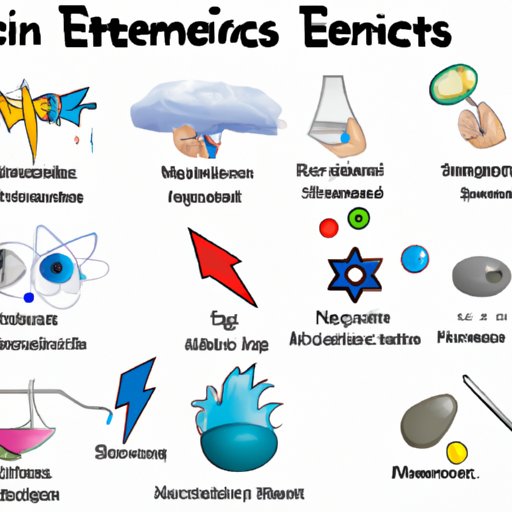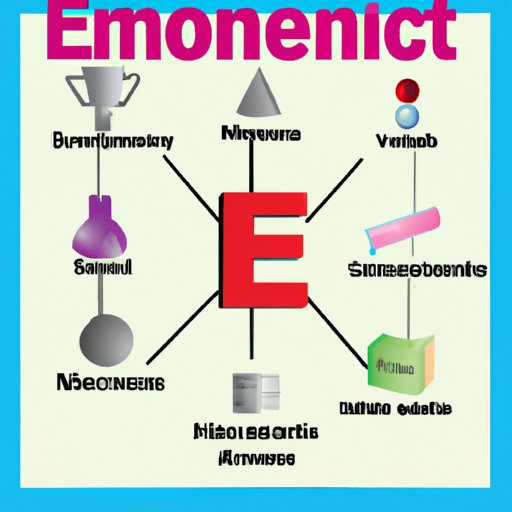Introduction
An element in science is a fundamental particle of matter that cannot be broken down into any other substances. Elements are made up of atoms, which are the smallest particles of matter that retain their chemical identity. There are currently 118 known elements, each with unique properties and characteristics. This article will explore what is an element in science, its role in science, and the importance of using elements in science.

Exploring the Basics of an Element in Science
What is an Element?
An element is a substance that cannot be decomposed or broken down into simpler components. They are the simplest and most basic form of matter. Elements are composed of atoms, which are the smallest particles of an element that have the same chemical properties. Atoms can combine to form molecules, which are two or more atoms bonded together.
Role of an Element in Science
Elements play a vital role in science by providing a foundation for studying the structure and behavior of matter. They are the building blocks of all matter and make up everything in the universe. Elements are used to study the physical and chemical properties of matter, as well as how different elements interact with one another.
Investigating the Definition of an Element in Science
Properties and Characteristics of an Element
Each element has unique properties and characteristics that make them distinct from one another. These properties include their atomic number, mass, boiling point, melting point, density, and reactivity. Atomic number refers to the number of protons in an atom, while mass refers to the total number of protons and neutrons. Boiling point is the temperature at which a substance turns into a gas, while melting point is the temperature at which a substance turns into a liquid. Density is the amount of mass per unit volume, while reactivity is the tendency of an element to form compounds with other elements.
Different Types of Elements
Elements can be divided into three main categories: metals, nonmetals, and metalloids. Metals are elements that are good conductors of heat and electricity, while nonmetals are elements that are poor conductors of heat and electricity. Metalloids are elements that have properties of both metals and nonmetals. Examples of metals include iron, copper, and aluminum, while examples of nonmetals are sulfur, oxygen, and nitrogen. Examples of metalloids are silicon, arsenic, and germanium.

Examining How Elements are Used in Science
Overview of Uses for Elements in Science
Elements are essential in a wide range of scientific studies and applications. They are used to create new materials, medicines, and technologies, as well as to study the structure and behavior of matter. Elements are also used in the production of energy and in the creation of synthetic materials.
Examples of Uses for Elements in Science
Elements are used in many scientific fields, such as chemistry, physics, and biology. In chemistry, elements are used to study the composition and structure of matter, as well as how different elements interact with one another. In physics, elements are used to study the behavior of matter and energy, as well as to develop new technologies. In biology, elements are used to study living organisms, as well as to create medicines and treatments.

Understanding the Importance of Elements in Science
Benefits of Using Elements in Science
Using elements in science has many benefits. They provide a foundation for studying the structure and behavior of matter, as well as how different elements interact with one another. Elements are also essential for creating new materials, medicines, and technologies, as well as for producing energy and synthetic materials.
Implications of Not Utilizing Elements in Science
Not utilizing elements in science can have severe implications. Without elements, scientists would not be able to study the structure and behavior of matter, nor would they be able to create new materials, medicines, and technologies. Additionally, energy production and synthetic materials would not be possible without elements.
Conclusion
Summary of the Article
This article explored what is an element in science, including its properties and characteristics, different types of elements, and how they are used in science. It also looked at the importance of elements in science and their benefits. Elements are fundamental particles of matter that cannot be broken down into any other substances. They provide a foundation for studying the structure and behavior of matter, as well as how different elements interact with one another. Additionally, elements are essential for creating new materials, medicines, and technologies, as well as for producing energy and synthetic materials.
Final Thoughts on Elements in Science
Elements are an essential part of science, and without them, many scientific studies and applications would not be possible. Understanding elements and their properties is key to advancing science and discovering new materials, medicines, and technologies. Therefore, it is important to continue researching and exploring elements in science.
(Note: Is this article not meeting your expectations? Do you have knowledge or insights to share? Unlock new opportunities and expand your reach by joining our authors team. Click Registration to join us and share your expertise with our readers.)
